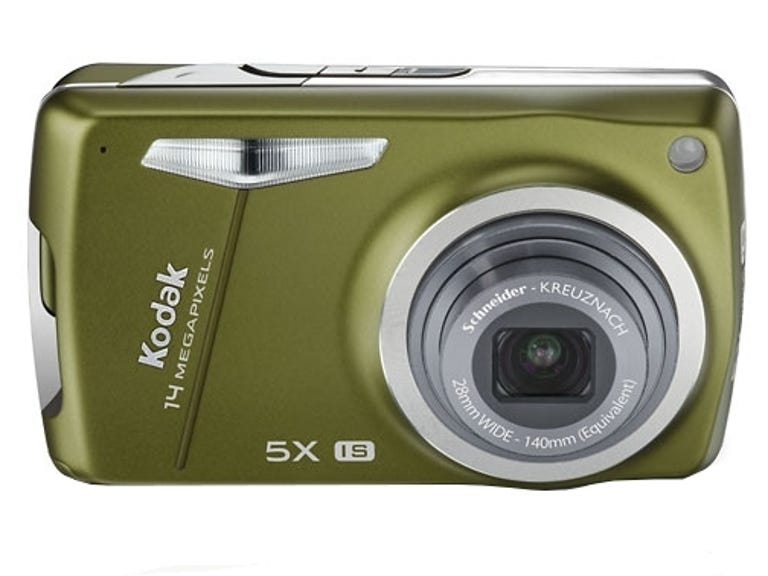 Why You Can Trust CNET
Why You Can Trust CNET Kodak EasyShare M575 review: Kodak EasyShare M575
The Kodak EasyShare M575 quietly raises the bar for sub-£100 digital cameras. It isn't without its negative points but ease of use and value for money are definitely not among them. Its picture quality is well above average for the price too.
Even if you're fairly skint, there are still plenty of options to choose from when it comes to buying a new compact camera. With a price tag of around £90 and built-in social-networking features, Kodak's EasyShare M575 certainly seems like a good choice for beginners or casual users looking for a cheap camera. But does the M575 have what it takes to stand out from the crowd?
The Good
The Bad
The Bottom Line
The shape of things
Available in three metallic colours (red, black or green), the M575 has that classic point-and-shoot look. It's small, slim and has a large, 3-inch screen on its rear, with no viewfinder in sight. On the front, the 5x optical zoom lens retracts into the body of the unit when not in use.
A conservative selection of buttons adorns the rear and top edges of the device, indicating that manual controls play second fiddle to the hands-off auto modes. Indeed the M575's default mode is called 'Smart Capture', which is basically Kodak-speak for 'just press the shutter button and we'll handle everything else'.

Tap the mode button on the top of the device, however, and you can select a specific scene preset from 21 different options, from portrait to panoramic. There's also a video mode that will let you film high-definition clips at up to 720p. Cameras that can record in 1080p are becoming increasingly numerous, but 720p recording is good for the M575's price range and is probably more than sufficient for the average YouTube user's purposes. The main disappointments in the video department are poor-quality sound and the fact that you can't make use of the camera's zoom while filming movies.
The M575 has a program mode too, which serves to reinstate many of the manual options that the Smart Capture mode keeps hidden. This means that you can, should you be so inclined, play around with settings such as white balance, exposure compensation and sensitivity. Doing so involves opening menus and scrolling through settings, so it's not a particularly intuitive process, but then manual control is unlikely to be at the top of many casual users' wishlists.
Features like face detection and image stabilisation are likely to be of more value to Kodak's target market. Thankfully, both are present. You can set the M575 to recognise and automatically tag up to 20 different people, and the camera can cope with up to five faces in any single shot.
Performance times
The M575 isn't particularly fast or slow -- start-up and between-shot times are both under 3 seconds. In most normal shooting situations, it should provide more than adequate image quality. The camera has a high-resolution, 14-megapixel sensor that will capture enough detail for you to print your pictures at larger-than-normal sizes while maintaining high levels of detail. Combined with a 5x zoom lens and the aforementioned image stabilisation, the hardware itself certainly has the potential to provide everything you need to take good photos.
Thankfully, the M575's real-world performance largely lives up to its specs. Outdoors, colours are mostly rich and true to life, including flesh tones, and the overall image is warm and sharp. There's plenty of detail where detail is present in your subject, although areas of solid strong or dark colours can sometimes seem odd if you look up close -- it's almost as if the camera is trying to smooth over certain areas and, in others, insert detail where there is none.
We also noticed noise in low-light and interior shots, when the sensitivity setting had been increased to ISO 320 to compensate for the dim conditions. (Using the built-in flash will help to avoid this.) That said, most of the picture gripes we have are relatively minor, particularly when the M575 is compared with other cameras of the same price.
Once you have an SD card full of snaps that you want to show to your friends and family, the camera's EasyShare features come into action. Sadly, there's no wireless Internet access or anything exciting like that. You'll need to make a physical connection with a PC, install some software and configure your social-networking or email settings before you can upload photos online. After this has been done once, zapping your shots into cyberspace is a largely single-button activity.
Conclusion
There are certainly better cameras available if you're willing to pay more money but the Kodak EasyShare M575 will fit the bill for beginners and those seeking a cheap snapper. It's light, fairly simple to use and often takes good photos, especially when it comes to portraits and group shots.
Edited by Charles Kloet


